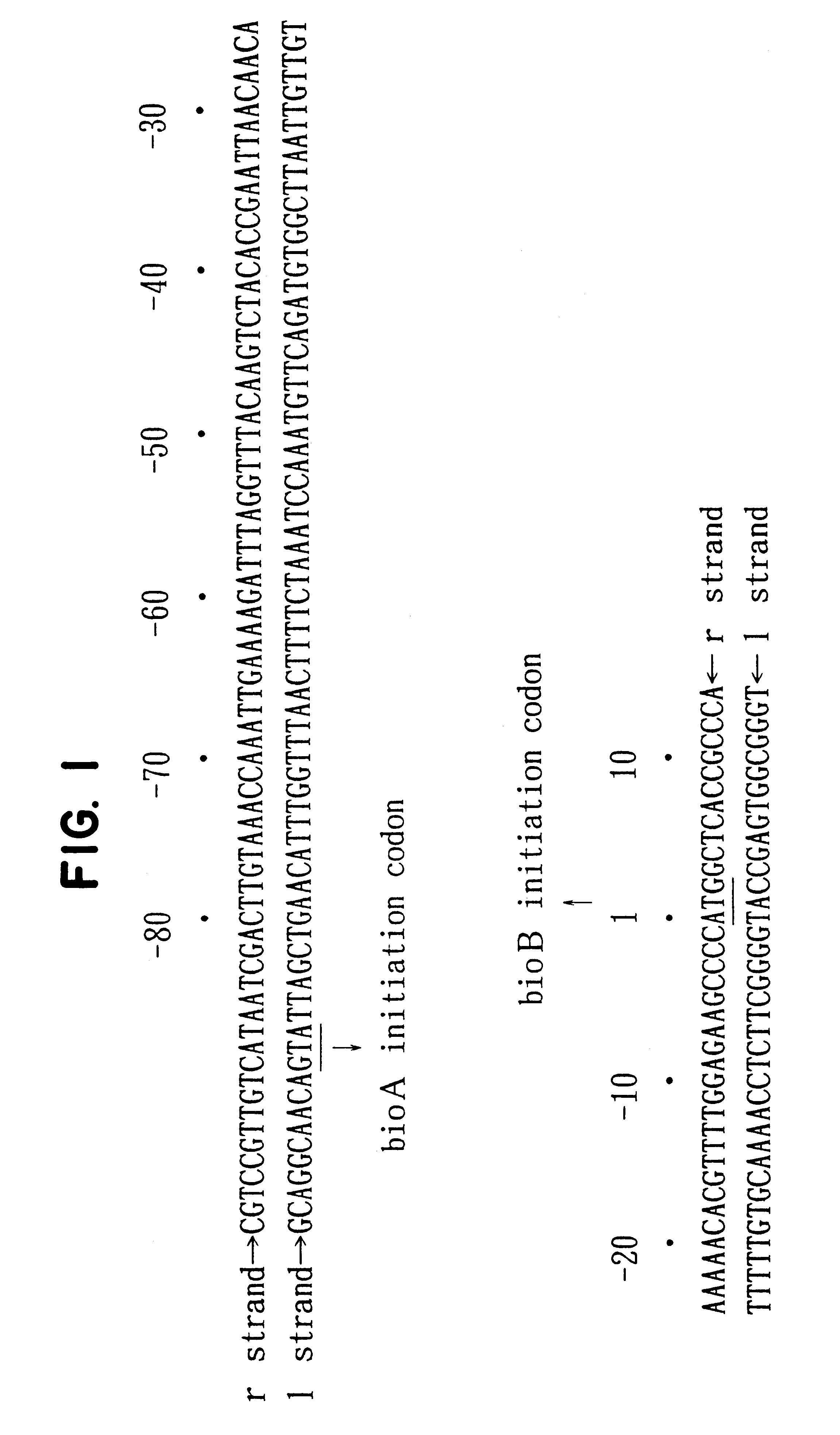Microorganism resistant to threonine analogue and production of biotin
a technology of threonine analogue and microorganisms, which is applied in the field of microorganisms, can solve the problems of unsatisfactory prior art processes for biotin production and high cost of biotin, and achieve the effect of high yield
- Summary
- Abstract
- Description
- Claims
- Application Information
AI Technical Summary
Benefits of technology
Problems solved by technology
Method used
Image
Examples
reference example 2
Escherichia coli ANA91 / pXBRP319 obtained in Reference Example 1 was grown at 37.degree. C. for 16 hours in a 200 ml creased flask containing a seed medium (pH 7.1, 30 ml) composed of glucose 2%, calcium carbonate 1%, corn steep liquor 4%, ammonium sulfate 0.4%, KH.sub.2 PO.sub.4 0.1%, K.sub.2 HPO.sub.4 0.2% and MgSO.sub.4.7H.sub.2 O 0.01% on a rotary shaker. The resulting culture (0.6 ml) was transferred to a 200 ml creased flask containing a main medium (pH 7.1, 30 ml) composed of glucose 5%, corn steep liquor 5%, ammonium sulfate 0.2%, DL-alanine 0.3%, KH.sub.2 PO.sub.4 0.1%, K.sub.2 HPO.sub.4 0.2%, MgSO.sub.4.7H.sub.2 O 0.01%, FeSO.sub.4.7H.sub.2 O 0.001% MnSO.sub.4.4-6H.sub.2 O 0.001% and thiamine hydrochloride 0.002%, and grown at 37.degree. C. for 30 hours on a rotary shaker at 220 rpm. After completion of the cultivation, the culture was centrifuged. The quantitative analysis of biotin in the culture supernatant showed that 160 mg / ml biotin was accumulated.
example 1
Escherichia coli ANA91 / pXBRP 319 obtained in Reference Example 1 was inoculated in 2.times.YT medium (20 ml) containing yeast extract 10 g / L, peptone 16 g / L and sodium chloride 5 g / L, and subjected to shaking culture at 37.degree. C. for 16 hours. The resulting culture solution (0.2 ml) was transferred to 2.times.YT medium (20 ml), and subjected to shaking culture at 37.degree. C. for 6 hours. The resulting culture broth was centrifuged, and the collected cells were rinsed twice with TM buffer (maleic acid 5.08 g / L, Tris 6.05 g / L, pH 6.0). The rinsed cells were suspended in TM buffer containing 200 .mu.g / ml of NTG, and subjected to mutagenesis at 37.degree. C. for 25 minutes. The treated cells were collected by centrifugation and rinsed twice with TM buffer, and suspended in the same buffer. The resulting suspension was inoculated in an agar plate of M9 minimal medium containing 2 g / L .beta.-hydroxynorvaline, and allowed to stand at 37.degree. C. for 5 days to obtain colonies of str...
example 2
Escherichia coli HNV148 / pXBRP319 obtained in Example 1 was grown at 37.degree. C. for 16 hours in a 200 ml creased flask containing a seed medium (pH 7.1, 30 ml) composed of glucose 2%, calcium carbonate 1%, corn steep liquor 4%, ammonium sulfate 0.4%, KH.sub.2 PO.sub.4 0.1%, K.sub.2 HPO.sub.4 0.2% and MgSO.sub.4.7H.sub.2 O 0.01% on a rotary shaker at 220 rpm. The resulting culture (0.6 ml) was transferred to a 200 ml creased flask containing a main medium (pH 7.1, 30 ml) composed of glucose 5%, corn steep liquor 5%, calcium carbonate 2%, ammonium sulfate 0.2%, DL-alanine 0.3%, KH.sub.2 PO.sub.4 0.1%, K.sub.2 HPO.sub.4 0.2%, MgSO.sub.4.7H.sub.2 O 0.01%, FeSO.sub.4.7H.sub.2 O 0.003%, MnSO.sub.4.4-6H.sub.2 O 0.003% and thiamine hydrochloride 0.002%, and grown at 37.degree. C. for 30 hours on a rotary shaker at 220 rpm. After completion of the cultivation, the culture was centrifuged. The biotin accumulation in the resulting culture supernatant was quantified by the bioassay using Lact...
PUM
| Property | Measurement | Unit |
|---|---|---|
| temperature | aaaaa | aaaaa |
| temperature | aaaaa | aaaaa |
| pH | aaaaa | aaaaa |
Abstract
Description
Claims
Application Information
 Login to View More
Login to View More - R&D
- Intellectual Property
- Life Sciences
- Materials
- Tech Scout
- Unparalleled Data Quality
- Higher Quality Content
- 60% Fewer Hallucinations
Browse by: Latest US Patents, China's latest patents, Technical Efficacy Thesaurus, Application Domain, Technology Topic, Popular Technical Reports.
© 2025 PatSnap. All rights reserved.Legal|Privacy policy|Modern Slavery Act Transparency Statement|Sitemap|About US| Contact US: help@patsnap.com


